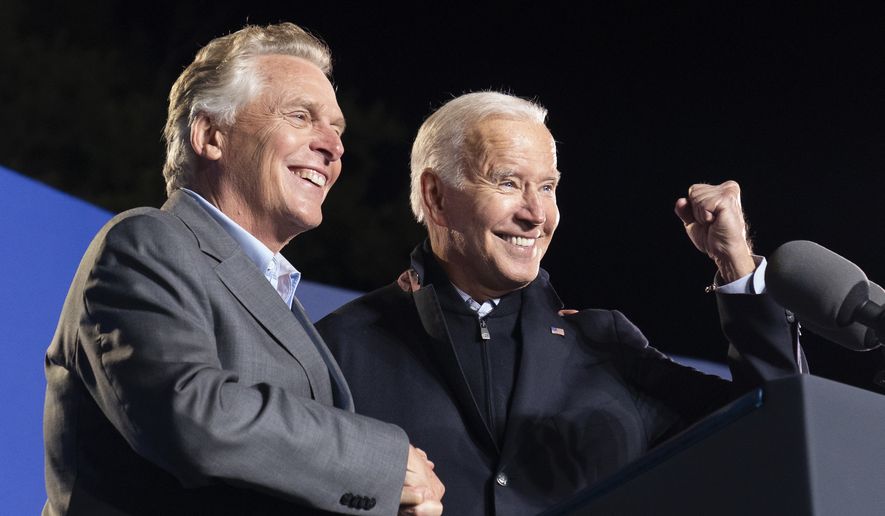OPINION:
Former President Donald Trump endorsed Virginia Republican gubernatorial candidate Glenn Youngkin not once but three times.
But Mr. Youngkin walked a tightrope throughout the campaign. He accepted the endorsements, but he kept Mr. Trump at arm’s length. As his Democratic opponent, Terry McAuliffe, brought in a string of heavy hitters — President Joe Biden (twice), former President Barack Obama, first lady Jill Biden and Vice President Kamala Harris — Mr. Youngkin didn’t invite Mr. Trump or other national party leaders and even steered clear of an 11th-hour telephone rally headlined by Mr. Trump.
Media reports the day after Mr. Youngkin pulled off the win in a state Mr. Biden won by more than 10% exactly one year ago are awash with claims that Trump was the decisive factor. Not so.
Exit polls deliver the proof. Just 42% of Virginia voters said they have a favorable view of Mr. Trump, while 54% hold an unfavorable view. But Mr. Biden’s numbers were the important ones: 45% said they approve of his job, while 54% disapprove. Mr. Biden’s approval rating has plunged more at this point in his presidency than any other president since World War II.
So hatred for Mr. Trump didn’t drive Democratic voters to the polls this time around, nor does it appear that support for Mr. Trump prompted a surge in turnout. Instead, dissatisfaction for Mr. Biden’s policies drove the vote — and kept many Democrats from showing up. Nearly 3 in 10 voters said they voted for the Republican as “a way to express opposition” to Mr. Biden, CNN reported. And even though Mr. McAuliffe spent most of his campaign trying to connect Mr. Youngkin to Mr. Trump, voters just didn’t buy it.
Mr. Biden has made a mess of things in just 287 days. Inflation has soared, a supply chain crisis has left stored shelves empty, a worker shortage has caused major problems, the southern border catastrophe is still unsolved, and the disastrous withdrawal from Afghanistan left a decidedly sour taste in voters’ mouths.
But Mr. Youngkin ran a race focused on local issues, especially the perceived anti-parent stance on education that exploded in Virginia in the campaign’s final weeks. Those two issues — the economy and education — drove the race, not Mr. Trump.
“About one-third of Virginia voters called the economy the most important issue facing the state, placing it ahead of other topics that dominated headlines in the closing days of the race. Just under one-quarter said education is most important, about 15% chose taxes, about 14% chose the COVID-19 pandemic and just about one-tenth chose abortion,” CNN reported.
Mr. Biden’s support among Democrats has also plummeted. Just 36 percent of Democratic voters want Mr. Biden to run again in 2024, while half think the country is on the wrong track, according to a recent NPR/PBS News poll.
Voter turnout — a true measure of enthusiasm among the party faithful — was also crucial. Consider these numbers: Mr. Biden crushed Mr. Trump in Virginia in 2020, winning 54.1% of the vote to Mr. Trump’s 44%. That 10.1% winning margin was the largest for a Democratic presidential candidate since 1944 when Franklin D. Roosevelt beat Thomas Dewey in the state 62.4% to 37.4%.
On Tuesday, more than 3.2 million Virginians voted, a 27% increase from 2017, the last election for governor. In that race, Democrat Ralph Northam defeated Republican Ed Gillespie 53.9% to 45%.
But in 2017, just 2,584,906 people voted in the state. This year, with 99% of the vote counted, 3,277,931 state residents cast ballots, according to FiveThirtyEight.
That surge in turnout gave Mr. Youngkin the win. He received 1,675,171 votes — a nearly 500,000-vote increase from Mr. Gillespie, who got 1,175,731 votes. Mr. McAuliffe pulled in 193,585 more votes than Mr. Northam — 1,602,760 versus 1,409,175. But it still wasn’t enough.
Exit polls showed independents went heavily for Mr. Youngkin.
“Youngkin also carried male voters in this year’s election by a roughly 12-point margin, White women without college degrees by about 50 points and White evangelicals by about 76 points — all broader margins than then-President Donald Trump posted over Joe Biden among those demographics in the 2020 election and than Republican Ed Gillespie posted over his gubernatorial rival in 2017,” CNN reported. “The early exit polling also suggests a slim advantage for Youngkin in the suburbs, an area that shifted toward Democrats during Trump’s presidency.”
So Mr. Youngkin’s win delivers a blueprint to the GOP for winning back the House and Senate in the 2022 mid-term elections. Embrace the local issues that most affect your state’s residents — and it’s OK to keep your distance from Mr. Trump. While the next national election is still a year away, economists don’t expect things to be much better.
“We’re going to have a whole new crop of Republicans come in and define a new way forward,” Mr. Youngkin told supporters the day before the election.
Indeed we are.
• Joseph Curl was a former White House reporter and current columnist for the Washington Times.




Please read our comment policy before commenting.